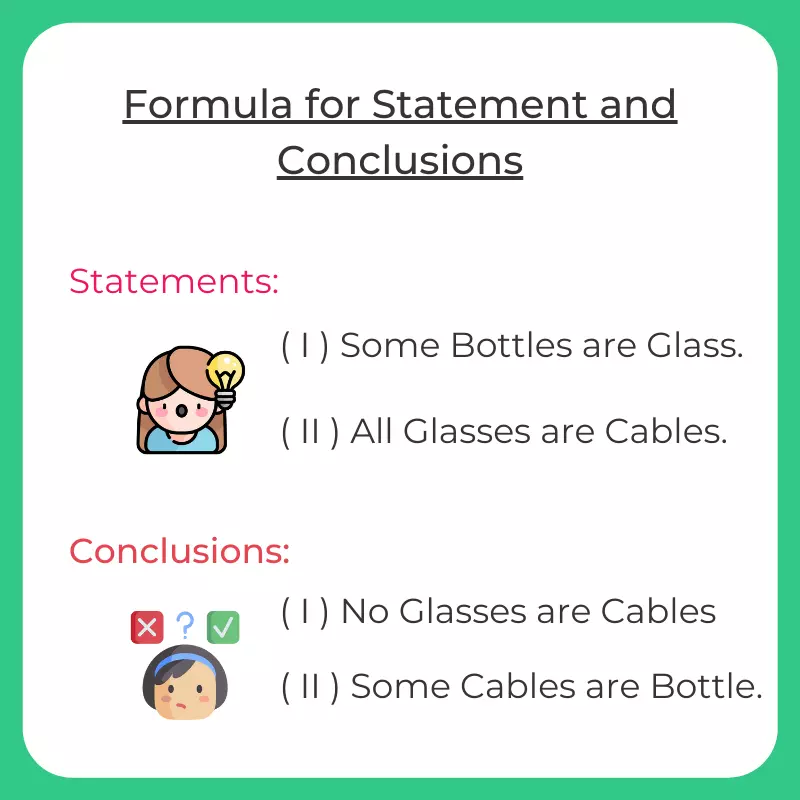Logical Menu
- Number Series
- Coding and Number Series
- Letter and Symbol Series
- Logical Sequence of Words
- Analogy and Classification Pattern
- Statements and Conclusions
- Statements and Assumptions
- Data Sufficiency
- Visual Reasoning
- Cube and Cuboid
- Cube
- Dice
- Directional Senses
- Blood Relations
- Odd Man Out
- Syllogism
- Arrangements
- Seating Arrangements
- Coding Deductive Logic
- Objective Reasoning
- Selection Decision Tables
- Attention to Details
- Inferred Meaning
- Cryprtarithmetic
- Get Off-campus Drive Updates
- Get Hiring Updates
- Contact US
PREPINSTA PRIME
Formula For Data Sufficiency
Formula for Data Sufficiency and Definitions
Important Formula for Data Sufficiency is given here on this page. In data sufficiency, questions are framed to examine students reasoning, logical and decision-making skills. For this, you must read the questions properly and based on the information given in the options you have to decide whether the information is sufficient to answer or not.

Understanding Solution Selections:
For solving data sufficiency questions you need to first understand the question and based on that, selection should be made. The questions will be asked with certain information with two statements labeled I and II. You need to analyze whether the information given in the label I and II is adequate to come to the solution or not. You should use all the data given in the statements along with your mathematics skill and well-known facts (such as sun rises in the east or the meaning of niece), the selection is to be made from below given options:
The answer can be obtained from Statement I alone but statement II alone is not sufficient to answer the question asked;
A. Data in statement 1 is sufficient alone to determine the answer.
B. Data in statement 2 is sufficient alone to determine the answer.
C. Data in either of the statements is sufficient to determine the answer.
D. Data provided in both the statements together are not sufficient to determine the answer.
E. Data in both statements are required to determine the answer.
Note: In data sufficiency problems, you can mark as “the data given in the statements is satisfactory” only when there is outcome or solution is in the numerical value.
Question 1.
Who is the father of A.
Statement I: x and y are brothers.
Statement II: y’s wife is the sister of A’s wife.
A. Data in statement 1 is sufficient alone to determine the answer.
B. Data in statement 2 is sufficient alone to determine the answer.
C. Data in either of the statements is sufficient to determine the answer.
D. Data provided in both the statements together are not sufficient to determine the answer.
E. Data in both statements are required to determine the answer.
Answer: D
Explanation:
The statement I gives the relation between X and Y. So statement I alone cannot determine the answer. Through statement II we can determine that Y is the brother-in-law of A. Thus using both the statements you cannot determine the father of A. hence option D is correct.
Question 2.
In which year was Dhoni born?
Statement :
At present Dhoni is 21 years younger to his father.
Dhoni’s brother, who was born in 2001, is 28 years younger to his father.
- 1 alone is sufficient while 2 alone is not sufficient
- 2 alone is sufficient while 1 alone is not sufficient.
- Either I or II is sufficient
- Neither I nor II is sufficient
- Both I and II are sufficient
Answer: Both 1 and 2 are sufficient
Explanation –
From both I and II, we find that Dhoni is (28 – 21) = 7 years older than his brother, who was born in 2001. So, Dhoni was born in 1996.
Question 3.
What will be the total weight of 80 books, each of the same weight ?
Statements:
One-fourth of the weight of each book is 5 kg.
The total weight of three books is 20 kilograms more than the total weight of two books.
- I alone is sufficient while II alone is not sufficient.
- II alone is sufficient while I alone is not sufficient
- Either I or II is sufficient
- Neither I nor II is sufficient
- Both I and II are sufficient
Answer: Either 1 or 2 is sufficient
Explanation –
From I, we conclude that the weight of each book = (4×5) kg = 20 kg.
So, total weight of 10 books = (20 x 10) kg = 200 kg.
From II, we conclude that:
Weight of each book = (weight of 3 book) – (weight of 2 book) = 20 kg.
So, total weight of 10 books = (20 x 10) kg = 200 kg.
Question 4.
How many children does Mahi have ?
Statements:
Harsha is the only daughter of Y who is the wife of Mahi.
Karan and Jivan are brothers of Mahi.
- I alone is sufficient while II alone is not sufficient
- II alone is sufficient while I alone is not sufficient
- Either I or II is sufficient
- Neither I nor II is sufficient
- Both I and II are sufficient
Answer: 1 alone is sufficient
Explanation –
From I, we conclude that Harsha is the only daughter of Mahi. But this does not indicate that Mahi has no son. The information given in II is immaterial.
Question 5.
How much was the total sale of the shop ?
Statements:
The shop sold 2500 units of masks each costing Rs. 15.
This company has no other product line.
- I alone is sufficient while II alone is not sufficient
- II alone is sufficient while I alone is not sufficient
- Either I or II is sufficient
- Neither I nor II is sufficient
- Both I and II are sufficient
Answer: Either 1 or 2 is sufficient
Explanation –
From I, total sale of 8000 units of masks = Rs. (2500 x 15) = Rs. 37500.
From II, we know that the company deals only in masks
This implies that sale of masks is the total sale of the shop, which is Rs. 37500.
Prime Course Trailer
Related Banners
Get PrepInsta Prime & get Access to all 200+ courses offered by PrepInsta in One Subscription
Also Check Out:
Get over 200+ course One Subscription
Courses like AI/ML, Cloud Computing, Ethical Hacking, C, C++, Java, Python, DSA (All Languages), Competitive Coding (All Languages), TCS, Infosys, Wipro, Amazon, DBMS, SQL and others
- Statements and Conclusions – Questions | Formulas | How to Solve Quickly | Tricks & Shortcuts
- Statements and Assumptions – Questions | Formulas | How to Solve Quickly | Tricks & Shortcuts
- Statements and Conclusions –
Questions |
Formulas |
How to Solve Quickly |
Tricks & Shortcuts - Statements and Assumptions –
Questions |
Formulas |
How to Solve Quickly |
Tricks & Shortcuts

 Apply For Jobs
Apply For Jobs Get Hiring Updates
Get Hiring Updates




Login/Signup to comment